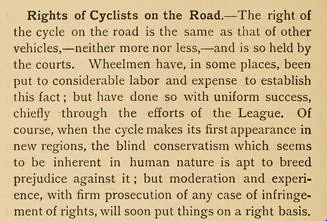Rights of Cyclists on the Road. — The right of the cycle on the road is the same as that of other vehicles, — neither more nor less, — and is so held by the courts. Wheelmen have, in some places, been put to considerable labor and expense to establish this fact; but have done so with uniform success, chiefly through the efforts of the League. Of course, when the cycle makes its first appearance in new regions, the blind conservatism which seems to be inherent in human nature is apt to breed prejudice against it; but moderation and experience, with firm prosecution of any case of infringement of rights, will soon put things on a right basis.

The more things change, the more they stay the same
Keeping in mind that this was before there were cars on these "highways" mentioned, it goes on to say:
In many localities wheelmen have been accorded advantages much in excess of their rights. They have been granted the privilege of using side paths and even paved walks; no objection has been made to their coasting on crowded hills, and forcing other vehicles from their track; and they have been permitted to ride at racing speed, even on crowded highways. Such concessions have had the effect of making many wheelmen very careless of the rights of pedestrians, and of those of drivers of wagons and carriages, while asserting their own rights and privileges to the full. By so doing they have intensified the prejudice already existing in some quarters against the sport, and have aroused the prejudice of others whose rights have been infringed by being rudely driven from their path, or portion of the road, by the necessity of giving ample space to some reckless rider. It is not only bad form and worse manners to act in this way, but it is most wretched policy, for it injures the whole body of wheelmen in the eyes of the public.In summary, cyclists have equal rights, but they should behave reasonably towards others. And if they have been accorded special rights, courtesy is to be expected.
Where roads are bad and wheelmen are permitted to use side paths, they ought to reciprocate the privilege accorded them by extending every possible courtesy to pedestrians, never warning them off the path by bell or whistle, but rather, by riding slowly and requesting the pedestrians to kindly allow their passage, and thanking them when they have done so. There are many cyclists who are thoughtless in these matters, and there are others who pretend to believe that it is pusillanimous to extend such courtesies ; but they ought to remember that they are on a path only by courtesy, and are bound, in common decency, to return that courtesy.
No comments:
Post a Comment